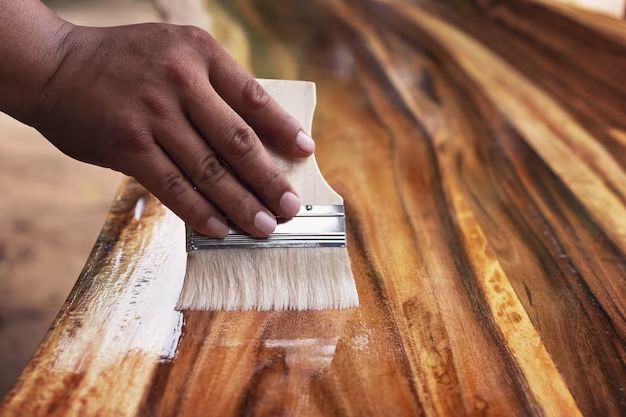When staining outdoor wood projects like decks, fences, pergolas and outdoor furniture, using the right number of coats is important for protection and appearance. The general rule of thumb is to apply two to three coats of exterior wood stain for optimal protection and color saturation. However, the specific number of coats needed depends on several factors.
Page Contents
How Many Coats of Stain for New Wood?
For new, unfinished exterior wood, three coats of stain are recommended. The first coat acts as a primer and seeps deep into the wood grains to lock out moisture. The second coat evens out the color. And the third coat provides extra protection and final color uniformity.
Applying three coats to new wood helps the stain last longer compared to just one or two coats. The extra layer of pigmented stain provides a thicker barrier against damaging UV rays, weathering and moisture damage.
Steps for Staining New Wood:
- Lightly sand the wood with 120-150 grit sandpaper to open the grains.
- Apply stain liberally with a brush or rag. Work it into the wood grains.
- Let the first coat dry as directed by the product instructions, usually 24-48 hours.
- Lightly sand again.
- Apply the second coat of stain and let dry completely.
- Apply the third and final coat. Allow extra drying time.
How Many Coats of Stain for Treated Wood?
For pressure-treated exterior wood, apply only two coats of stain. The wood treatment chemicals interfere with stain absorption, so the coloring won’t be as deep. Attempting three coats likely won’t provide much additional color or protection.
Two quality coats allow for adequate stain penetration and protection on treated lumber. Though the overall color intensity may be lighter compared to untreated wood with three coats.
Application Tips for Treated Wood:
- Let the treated wood dry out for 3-6 months before staining.
- Use a wood brightener to help remove any gray, weathered surface fibers.
- Apply an oil-based primer if the treated wood has a green tint.
- Choose a stain formulated for treated wood.
- Apply two coats as directed, allowing proper dry time between coats.
How Many Coats of Stain Based on Project Type
The number of stain coats needed also depends on the specific project type. Denser woods and projects that see heavier foot traffic may need extra protection.
Decks:
Apply three coats of deck stain for full protection. Decks endure a lot of wear and weathering.
Fences:
Two to three coats. Rough-sawn wood may need three coats for an even appearance.
Outdoor Furniture:
Two coats for most furniture like chairs, tables, benches. Softer woods like cedar may need three coats.
Pergolas:
Two coats for the roof beams and braces. Go with three coats for pergola posts embedded in the ground.
Siding and Trim:
Two coats for basic protection. Go with three for cedar and redwood siding.
Factors that Determine Coats of Stain Needed
Here are some key factors that can dictate the number of coats to apply:
1. Type of Wood
Soft, porous woods like pine, cedar and redwood absorb more stain for deeper coloring. Go with three coats for full color saturation on these woods.
On dense hardwoods like mahogany that resist absorption, two coats is usually sufficient.
2. Age of Wood
Old wood that’s weathered and gray will soak up more stain. Go with three coats for grayed wood to fully cover.
New wood with minimal weathering only needs two coats since it readily absorbs stain.
3. Surface Texture
Rough-sawn wood has deeper grooves that may need an extra coat of stain to get color uniformity. Smooth planed boards generally require just two coats.
4. Sun Exposure
High sunlight areas cause wood stain to fade faster. Apply three coats for wood with full sun exposure to extend the finish.
Wood with mostly shade or indirect sun can get by with two coats.
Best Practices for Applying Stain
Follow these tips for flawless results when using exterior wood stain:
- Always test stain on a scrap piece first to ensure desired color.
- Apply when temperatures are between 50-90°F.
- Use a high quality natural bristle brush.
- Maintain a wet edge to prevent lap marks.
- Brush with the direction of the wood grain.
- Allow proper dry time between coats.
- Lightly sand between coats for maximum adhesion.
- Add a tinted topcoat for extra protection and durability.
How Long Does Exterior Stain Last?
On average, exterior wood stains last 2-4 years before needing to be reapplied. Higher quality stains may last 5-7 years. Factors like sun exposure, weather, wood type and surface preparation impact the lifespan.
Using the right number of coats extends the finish. Stain with only one coat may last just 1-2 years. An optimal two coats can last 3-5 years. And three coats may endure for 5-7 years.
Also, reapplying just a single maintenance coat when the finish starts looking faded and worn can refresh the color and add a few more years of life.
Conclusion
Choosing the right number of stain coats comes down to the type of wood, project demands and desired longevity. For most exterior projects, two quality coats provide sufficient protection and color. But three coats is recommended for new wood or extra durability. As long as the previous coat is fully dry, adding more stain layers cannot hurt.
